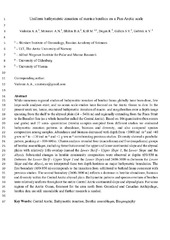| dc.contributor.author | Vedenin, A.A. | |
| dc.contributor.author | Mironov, A | |
| dc.contributor.author | Bluhm, Bodil | |
| dc.contributor.author | Käß, M | |
| dc.contributor.author | Degen, R | |
| dc.contributor.author | Galkin, S V. | |
| dc.contributor.author | Gebruk, A. | |
| dc.date.accessioned | 2023-02-14T10:21:36Z | |
| dc.date.available | 2023-02-14T10:21:36Z | |
| dc.date.issued | 2022-02-19 | |
| dc.description.abstract | While numerous regional studies of bathymetric zonation of benthic fauna globally have been done, few large-scale analyses exist, and no ocean-scale studies have focused on the Arctic Ocean to date. In the present work we, hence, examined bathymetric zonation of macro- and megabenthos over a depth range spanning from the shelf to the abyssal plain (14 – 5416 m) and regionally extending from the Fram Strait to the Beaufort Sea (as a whole hereafter called the Central Arctic). Based on 104 quantitative (box-corers and grabs) and 37 semi- quantitative (trawls) samples compiled from different studies we evaluated bathymetric zonation patterns in abundance, biomass and diversity, and also compared species composition among samples. Abundance and biomass decreased with depth from > 3000 ind. m<sup>−2</sup> and > 40 g ww m<sup>−2</sup> to ∼ 130 ind. m<sup>−2</sup> and < 1 g ww m<sup>−2</sup> corroborating previous studies. Diversity showed a parabolic pattern, peaking at ∼ 100–600 m. Cluster analysis revealed four (macrofauna) and five (megafauna) groups of benthic assemblages, including three that covered the upper and lower continental slope and the abyssal plains with relatively little overlap (named the Lower Shelf – Upper Slope 1, the Lower Slope and the Abyss). Substantial changes in benthic community composition were observed at depths 650–950 m (between the Lower Shelf – Upper Slope 1 and the Lower Slope) and 2600–3000 m (between the Lower Slope and the Abyss), so we interpreted these two depth horizons as major bathymetric boundaries. The first boundary (650–950 m) corresponds to the transition from sublittoral to bathyal fauna consistent with previous studies. The second boundary (2600–3000 m) reflects a decrease in benthic abundance, biomass and diversity within the Central Arctic abyssal plain. Bathymetric patterns and species overturn of benthos were relatively uniform throughout the entire Central Arctic continental slope and abyssal plain. For some regions of the Arctic Ocean, foremost for the area north from Greenland and Canadian Archipelago, benthic data are still unavailable and further research is needed. | en_US |
| dc.identifier.citation | Vedenin A, Mironov A, Bluhm B, Käß M, Degen R, Galkin SV, Gebruk A. Uniform bathymetric zonation of marine benthos on a Pan-Arctic scale. Progress in Oceanography. 2022;202 | en_US |
| dc.identifier.cristinID | FRIDAID 2107030 | |
| dc.identifier.doi | 10.1016/j.pocean.2022.102764 | |
| dc.identifier.issn | 0079-6611 | |
| dc.identifier.issn | 1873-4472 | |
| dc.identifier.uri | https://hdl.handle.net/10037/28554 | |
| dc.language.iso | eng | en_US |
| dc.publisher | Elsevier | en_US |
| dc.relation.journal | Progress in Oceanography | |
| dc.rights.accessRights | openAccess | en_US |
| dc.rights.holder | Copyright 2022 The Author(s) | en_US |
| dc.rights.uri | https://creativecommons.org/licenses/by/4.0 | en_US |
| dc.rights | Attribution 4.0 International (CC BY 4.0) | en_US |
| dc.title | Uniform bathymetric zonation of marine benthos on a Pan-Arctic scale | en_US |
| dc.type.version | acceptedVersion | en_US |
| dc.type | Journal article | en_US |
| dc.type | Tidsskriftartikkel | en_US |
| dc.type | Peer reviewed | en_US |


 English
English norsk
norsk
